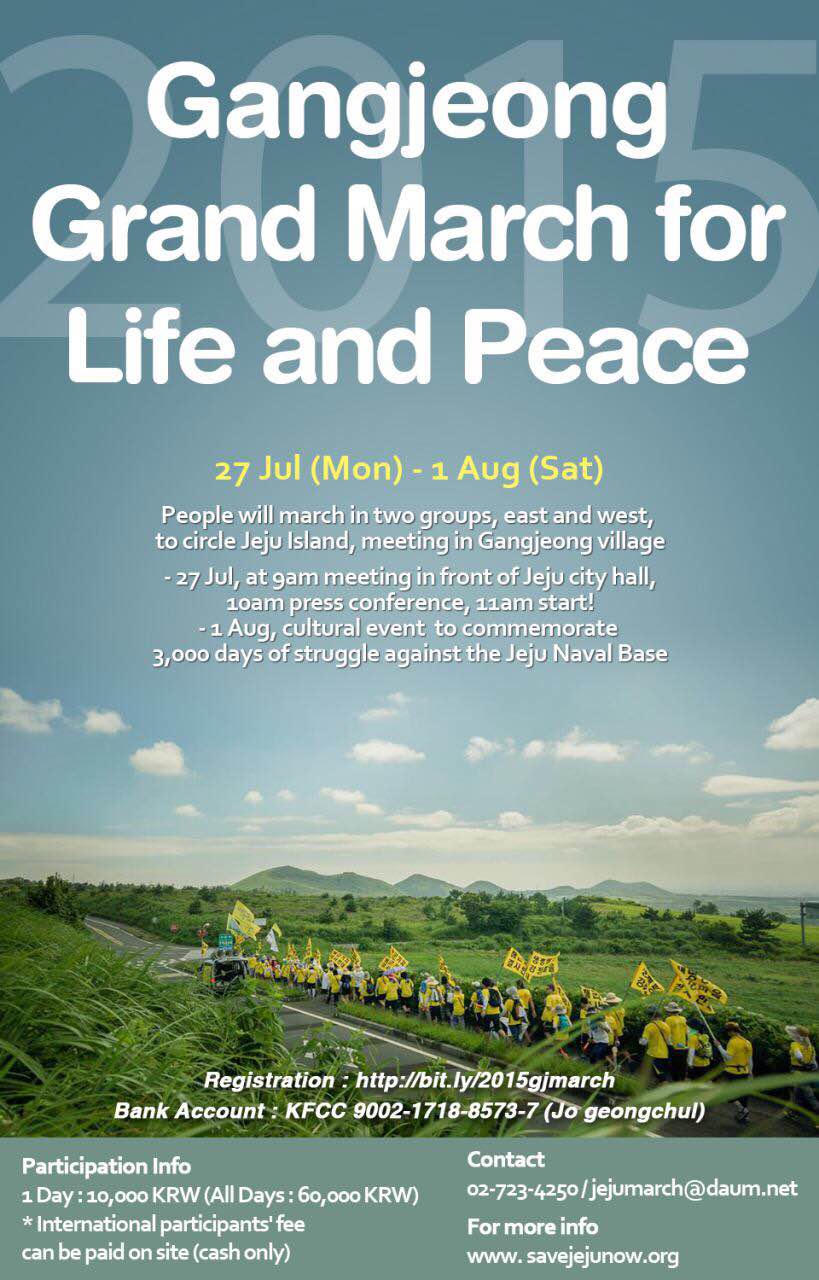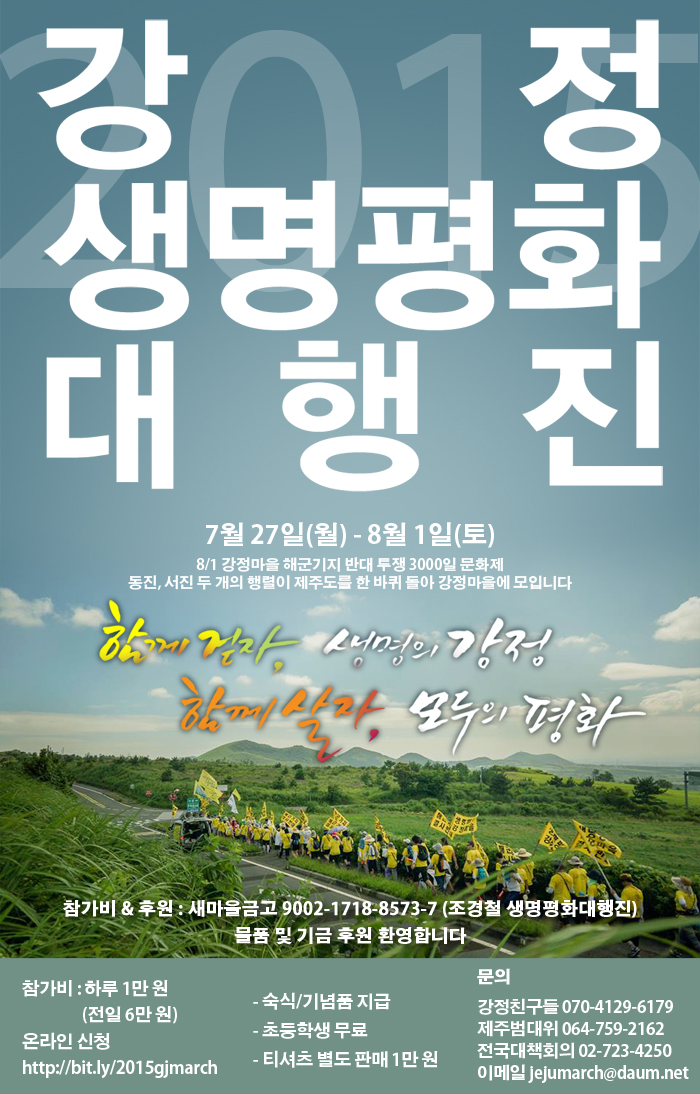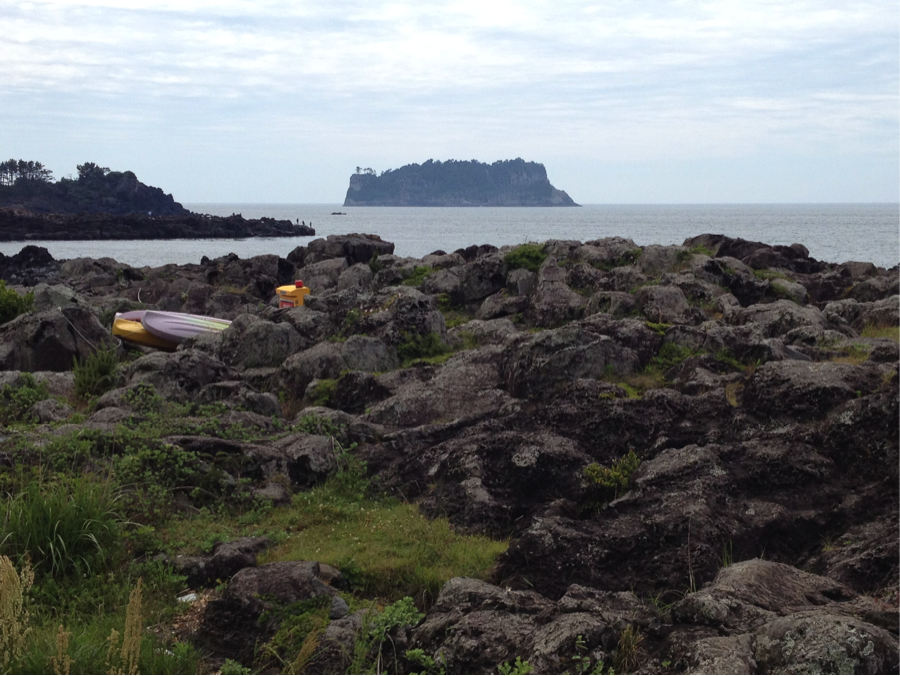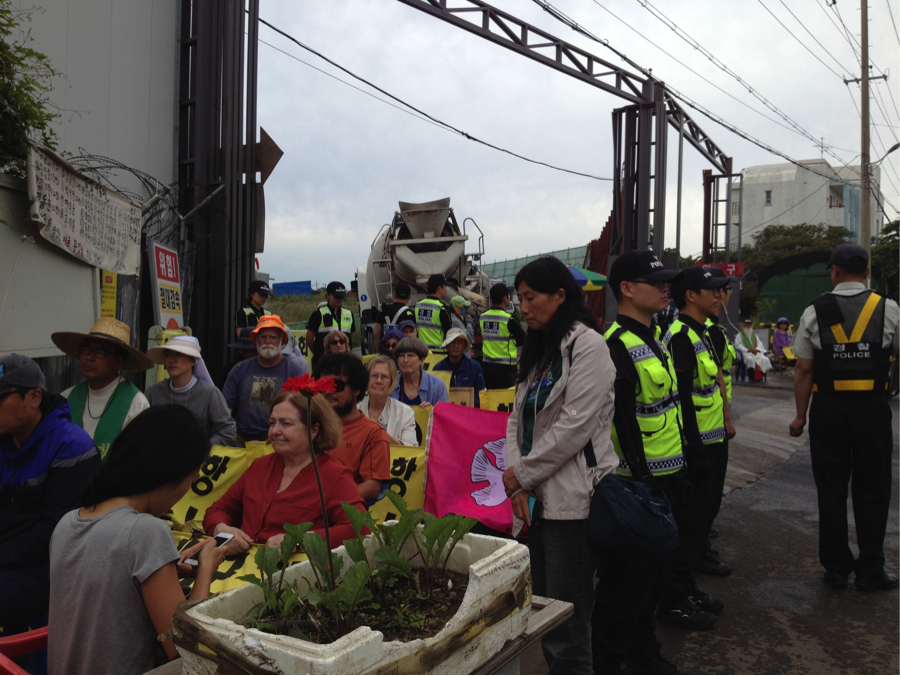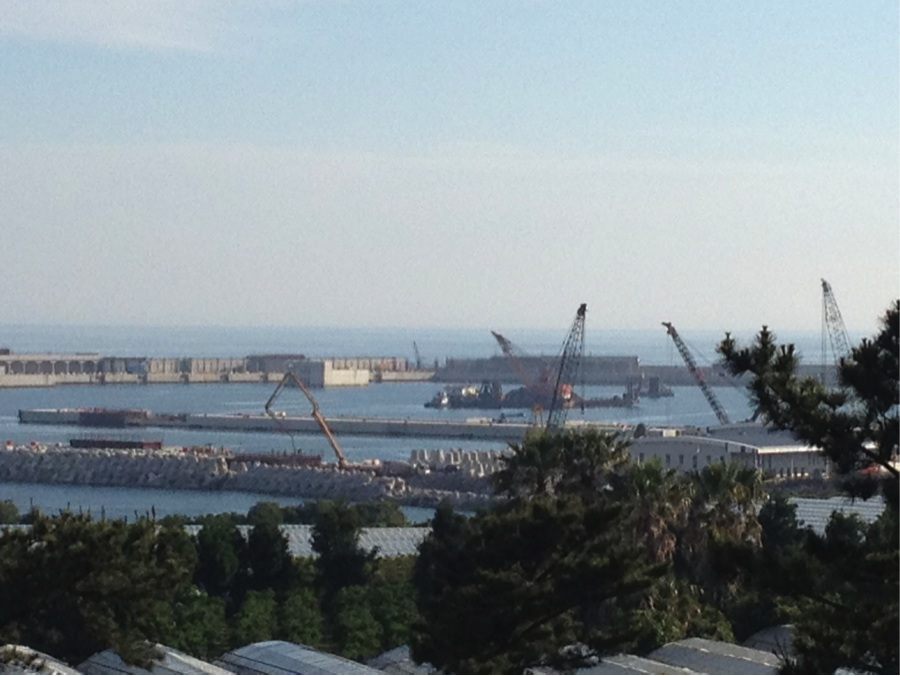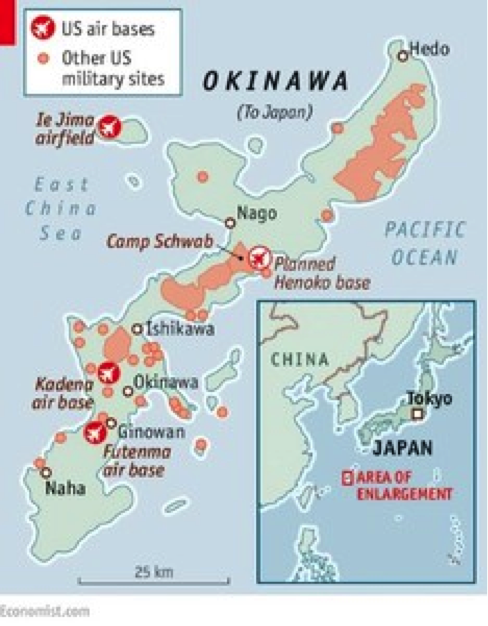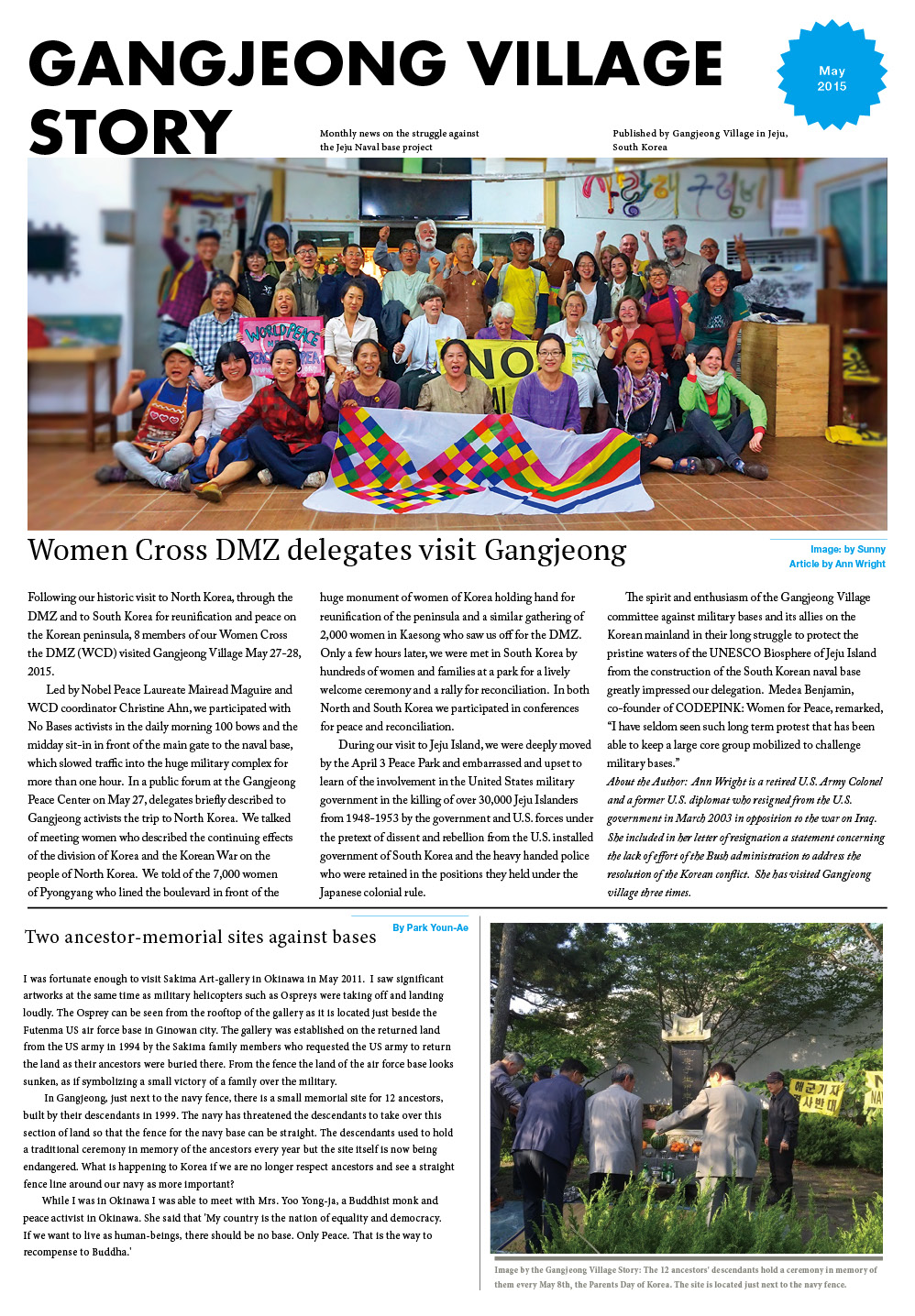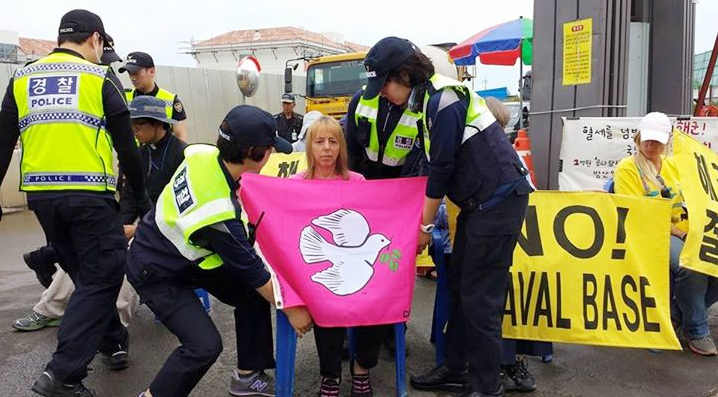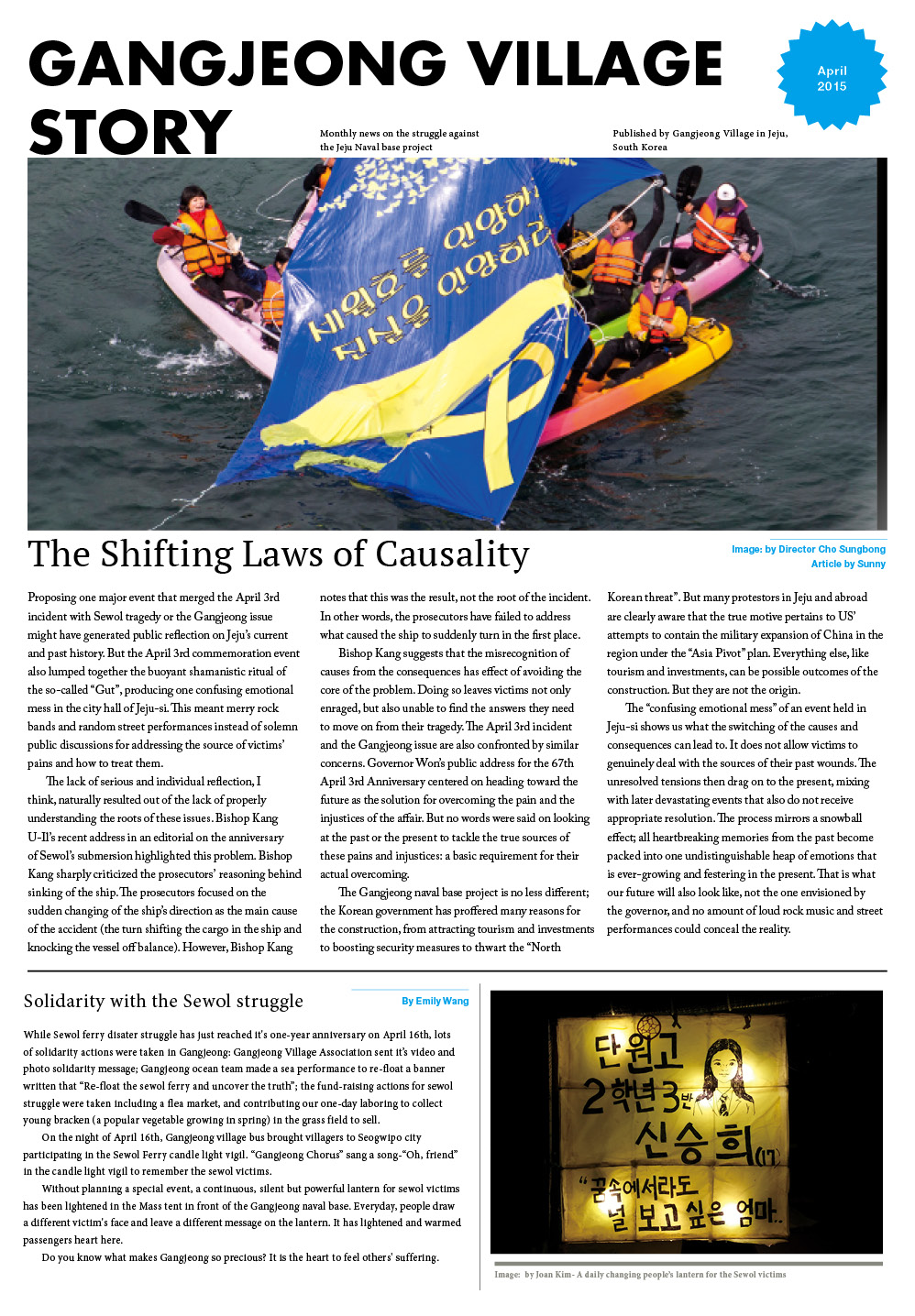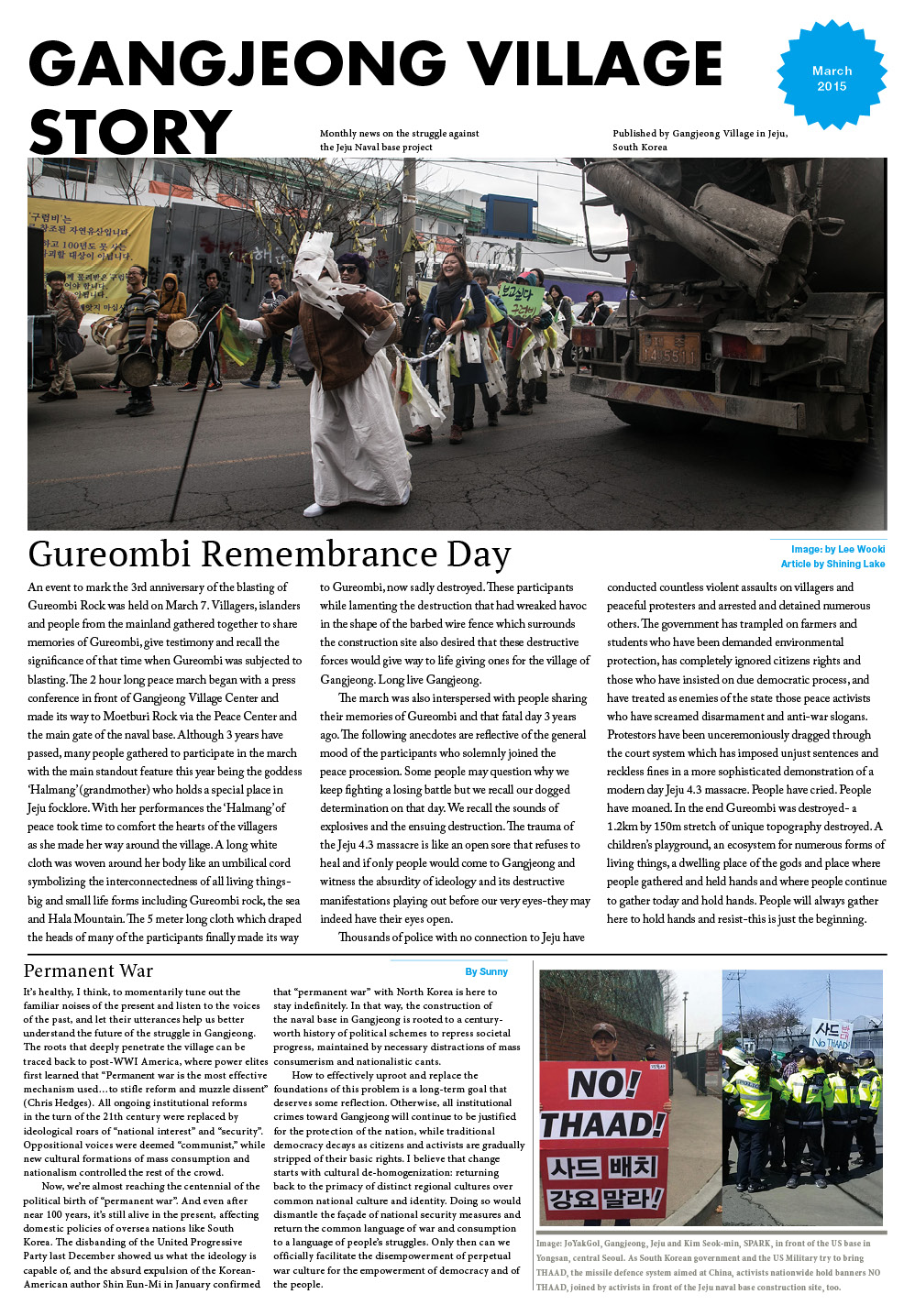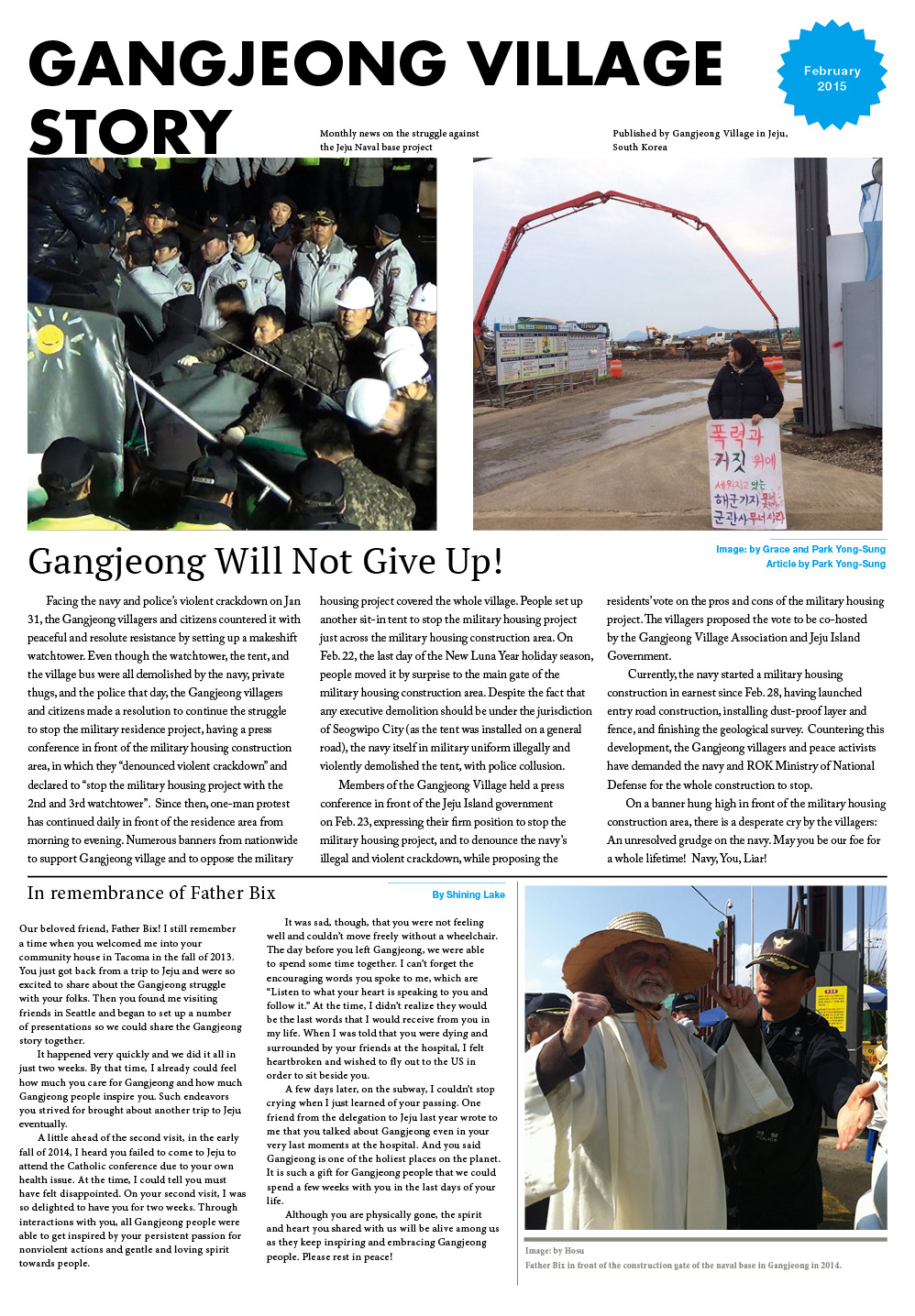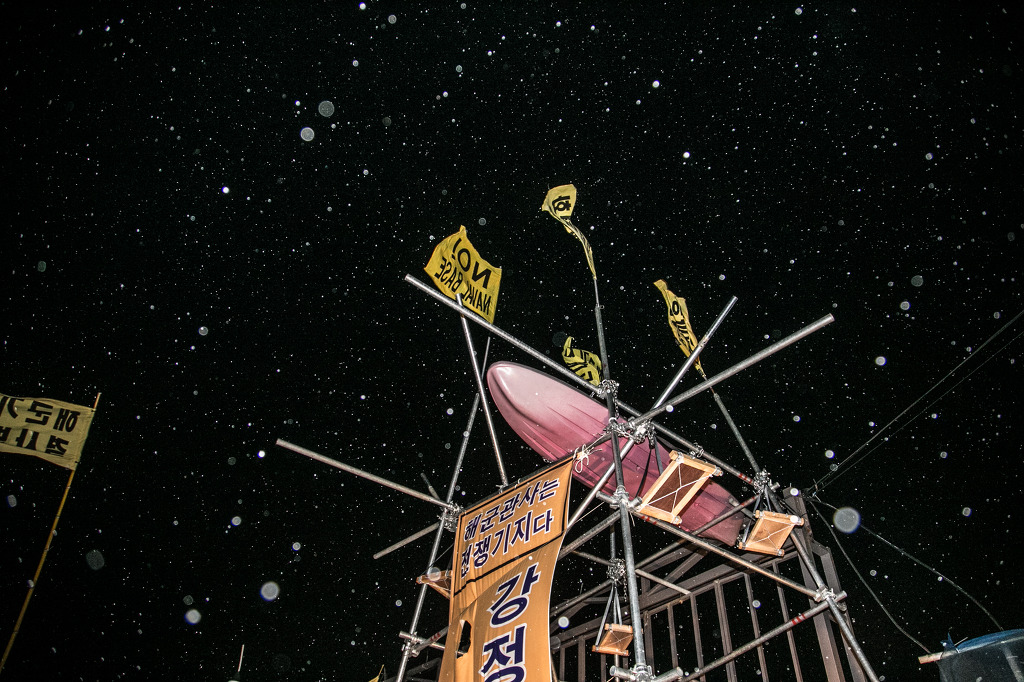
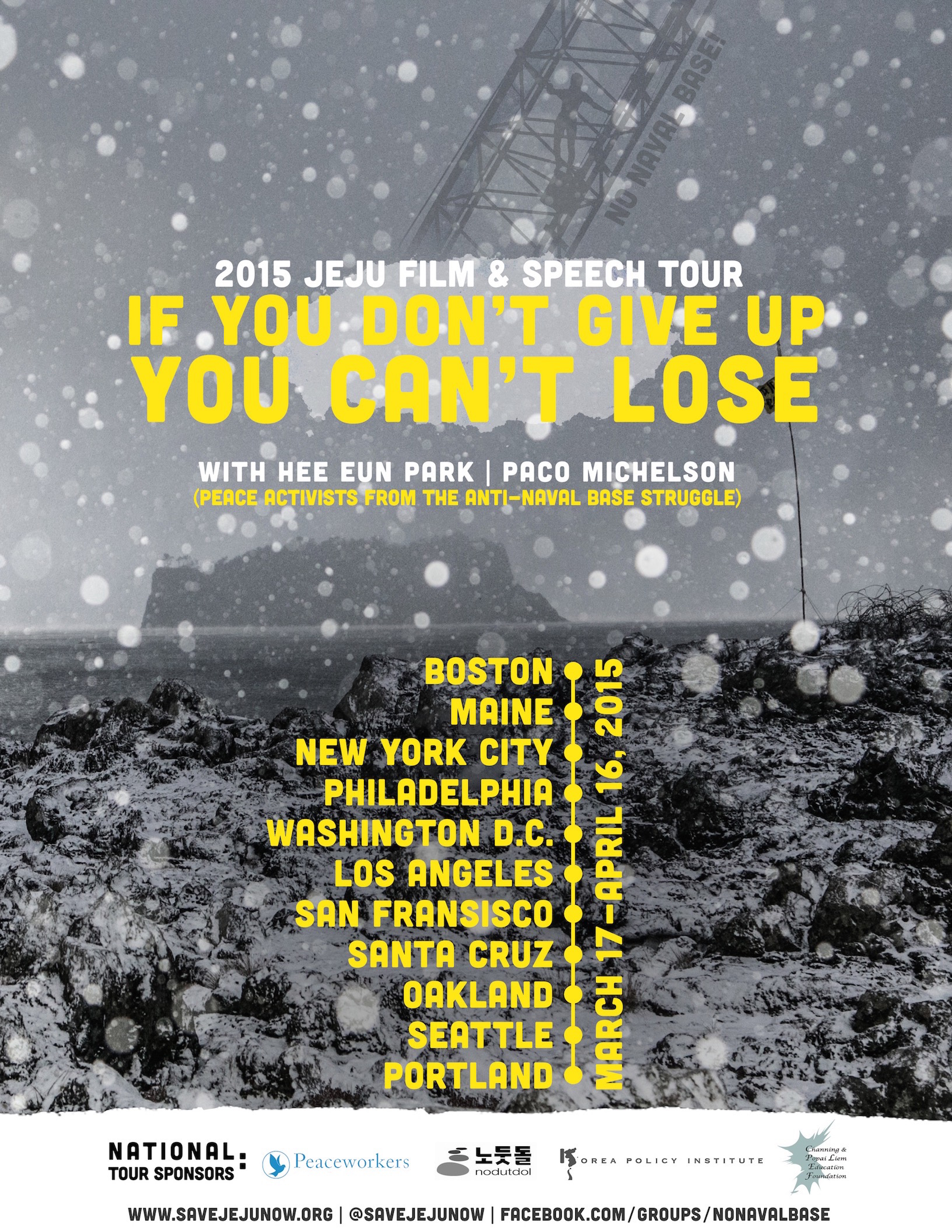
If You Don’t Give Up You Can’t Lose / Gureombi, The Wind is Blowing Film and Speech Tour 2015
Hee Eun “Silver” Park and Paco Michelson, peace activists from the Jeju Island Anti-Naval Base struggle will be traveling across the US in March and April to share the story of the struggle through the screening of a new full-length documentary, and speaking about their personal experiences on Jeju Island, Korea.
Since 2007, the people of Gangjeong and their supporters have struggled everyday against state violence, corporate power, war profiteering, and environmental destruction. They have done so nonviolently and passionately. As a result of their work for peace, the tiny village of Gangjeong now has one of the highest “crime” rates in all of South Korea. More than 220,000 police officers (as of 2012) have been stationed in Gangjeong. So far, more than 700 arrests have been made, leading to approx. 200 court cases for more than 650 people, approx. $270,000 in fines levied, and 46 imprisonments. More than 30 internationals have been blacklisted, deported, or denied entry. All for the “crime” of peacefully resisting the construction of a naval base that threatens villagers’ livelihoods, the local ecology, and the peace of northeast Asia.
At some events, Silver and Paco will be presenting the film of Korean director Sung Bong Cho, Gureombi, The Wind is Blowing followed by a Q&A. At others, they will be speaking about the situation and struggle as well as sharing their personal experiences and those of their friends on Jeju, with a presentation titled, If You Don’t Give Up You Can’t Lose.
At all events they will be raising support for legal costs of the activists and villagers of Gangjeong. Many of Gangjeong villagers are farmers whose struggle for justice has meant sacrificing their crops. Many Gangjeong supporters work full-time for the struggle and rely on odd jobs and occasional field labor to survive. The fines are increasing and many people owe thousands of dollars they cannot afford to pay.
Come out to an event in an area near you and hear the story, see the struggle, and donate to the brave peacemakers who are giving everything they can in this fight for justice.
Schedule Overview:
Click on a location to go to that locations section in the list.
March 17-19 – Boston, MA
March 19-21 – Maine
March 21-25 – NYC, NY
March 25 – New Brunswick, NJ
March 26-28 Philadelphia, PA
March 28-30 Washington, DC
March 30-April 4, Los Angeles & San Diego, CA
April 4-9 – San Francisco, Oakland, Berkeley, CA
April 9-14 Seattle, WA (and Surrounding Area)
April 14-20 – Portland, OR (and Surrounding Area)
Detailed Schedule:
All events listed below are open to the public. There are occasionally non-public events as well, check with your local groups in your area for details on those.
Boston
March 16 (Mon) – March 19 (Thursday)
March 17 – Talk and Discussion: If You Don’t Give Up You Can’t Lose
Date: March 17 (Tue)
Time: 7 p.m.
Organizer: Boston College Korean Students Association
Location: Higgins 310, Boston College (140 Commonwealth Ave, Chestnut
Hill, MA 02467)
Contact Info: Ramsay Liem (liem@bc.edu / 617-777-5627)
Website: http://on.fb.me/1B5qHlN
March 18 – Film Screening and Q&A: Gureombi, The Wind is Blowing
Date: March 18 (Wed)
Time: 7 p.m.
Organizer: American Friends Service Committee, United for Justice
with Peace
Location: Friends Meeting House (5 Longfellow Park, Cambridge, MA 02138)
Contact Info: Joe Gerson (jgerson@afsc.org), Duncan McFarland
(mcfarland13@gmail.com)
Website: http://masspeaceaction.org/event/jeju-island-gureombi
http://on.fb.me/1B5qWgv
Maine
March 19 (Thursday) – March 21 (Saturday)
March 20 – Film Screening and Q&A: Gureombi, The Wind is Blowing
Date: March 20 (Fri)
Time: 7 pm
Organizer: Global Network Against Weapons & Nuclear Power in Space, PeaceWorks, Maine Veterans For Peace, CodePink Maine, Peace Action Maine
Location: Grace Episcopal Church (1100 Washington St (park in back off Edwards St)
Bath, Maine)
Contact Info: Bruce Gagnon (globalnet@mindspring.com / 443-9502)
Website: http://space4peace.blogspot.com/2015/03/jeju-island-activists-coming-to-maine_10.html
March 21 – Rally at Bath Iron Works
Date: March 21 (Sat)
Time: 11:30 am
Organizer: Peace Works, Code Pink, Veterans for Peace, Smilin’ Trees
Disarmament Farm
Location: Bath Iron Works, Bath, Maine
Contact Info: Bruce Gagnon (globalnet@mindspring.com)
NYC
March 21 (Saturday) – March 25 (Wednesday)
March 22 – Talk and Discussion: If You Don’t Give Up You Can’t Lose
Date: March 22 (Sun)
Time: 2 pm – 5 pm
Organizer: Nodutdol for Korean Community Development
Location: The New School, Dorothy Hirshon Suite, Arnhold Hall, (55 West 13th Street, Room I205, New York, NY 10011)
Contact Info: Juyeon (juyeon.jc@gmail.com / 917-656-0156)
Website: http://on.fb.me/1B5r53r
March 23 – Film Screening and Q&A: Gureombi, The Wind is Blowing
Date: March 23 (Mon)
Time: 6:40-9:00 pm
Organizer: Monica Kim
Location: Cantor Film Center (36 E 8th St,Manhattan, NY 10003, bet. Greene St. and University
Place)
Contact Info: Monica Kim (mstarkim@gmail.com / 517-214-8003)
Website: http://on.fb.me/1B5rcfE
New Brunswick
March 25 (Wednesday)
March 25 – Film Screening and Q&A: Gureombi, The Wind is Blowing
Date: March 25 (Wed)
Time: 7 p.m.
Organizer: Graduate Union of Sociology Students
Location: Rutgers University (Davison Hall Room 128, Douglas Campus, 26 Nichol Avenue, New Brunswick, NJ 08901)
Contact Info: Haruki Eda (contact address is deleted by his request)
Philadelphia
March 26 (Thursday) – March 28 (Saturday)
March 26 – Talk and Discussion: If You Don’t Give Up You Can’t Lose
Date: March 26 (Thurs)
Time: 7-8:30 p.m.
Organizer: Philadelphia Committee For Peace and Justice in Asia
Location: Calvary United Methodist Church (815 South 48th Street,
Philadelphia, PA 19143)
Contact Info: Hye-Jung Park (hjparkcorea@yahoo.com / 347-283-6065)
Website: http://on.fb.me/1B5roeO
March 27 – Film Screening and Q&A: Gureombi, The Wind is Blowing
Date: March 27 (Fri)
Time: 8 p.m.
Organizer: Circle of Hope Church, Circle of Peacemakers
Location: Circle of Hope Church (2007 Frankford Ave Philadelphia PA 19125)
Contact Info: Joshua Grace (joshua@circleofhope.net / 215 423 2880)
Website: http://on.fb.me/1B5rsLo
Washington, DC
March 28 (Saturday) – March 30 (Monday)
March 28 – Talk and Discussion: If You Don’t Give Up You Can’t Lose
Date: March 28 (Sat)
Time: 5-8:30 pm
Organizer: Act Now to Stop War and End Racism (ANSWER)
Location: ANSWER National Office (617 Florida Avenue, NW, Washington, D.C.20001)
Contact Info: Sarah Sloan (sarahsloan930@yahoo.com / 202-904-7949)
Website: http://on.fb.me/1B5rBhS
March 29 – Film Screening and Q&A: Gureombi, The Wind is Blowing
Date: March 29 (Sun)
Time: 7 p.m.
Organizer: Coalition of Koreans In the U.S. (희망연대)
Location: William Cho Peace Center (3883 Plaza Drive, Fairfax, VA 22030)
Contact Info: Huk-Kyo Suh (hksuh2003@yahoo.com / 704-314-1489)
LA & San Diego
March 30 (Monday) – April 4 (Saturday)
March 31 – Film Screening and Q&A: Gureombi, The Wind is Blowing w/CPT
Date: March 31 (Tues)
Time: 7-9:30 p.m.
Organizer: Reconciliasian / Christian Peacemaker Teams
Location: Casa Robles Missionary Community (6355 Oak Avenue, Temple
City, CA 91780)
Contact Info: Sue Hur (reconciliasian@gmail.com)
Website: https://www.facebook.com/events/761540473966887/
April 1 – Film Screening and Q&A: Gureombi, The Wind is Blowing
Date: April 1 (Wed)
Time: 3-5 p.m.
Organizer: UCSD’s Ethnic Studies Department Colloquium, Program in Transnational Korean Studies, Graduate Division Grad Life and Grad Climate Interns, and Coalition for Critical Asian American Studies
Location: UCSD Cross-Cultural Center – ArtSpace, University of California, San
Diego (9500 Gilman Dr, La Jolla, CA 92093)
Contact Info: Esther Choi (estherminchoi@gmail.com)
Website: https://www.facebook.com/events/1566580410258374/
April 2 – Film Screening and Q&A: Gureombi, The Wind is Blowing
Date: April 2 (Thurs)
Time: 7 p.m.
Organizer: Nanum Corean Cultural Center (우리문화나눔회), Peace21 (내일을 여는
사람들), Friends of the Progressives (진보의 벗), Koreatown Immigrant Workers Alliance (KIWA)
Location: Abundant Life of Korean Church (3020 Wilshire Bl., Los Angeles, CA 90010)
Contact Info: Cheol-Ho Lee (icydewdrop@gmail.com, 424-281-7901), Danny
Park (danny2680@gmail.com)
Website: https://www.facebook.com/events/942948465728887/
April 3 – Talk and Discussion:If You Don’t Give Up You Can’t Lose
Date: April 3 (Fri)
Time: 7-9 p.m.
Organizer: SOOBAK (SoCal Organized Oppression Breaking Anti-imperialist
Koreans)
Location: 2936 W 8th St. Los Angeles, CA 90005
Contact Info: Gonji Jessica Lee (jessica.kang.lee@gmail.com)
Website: https://www.facebook.com/events/805579472859691/
San Francisco, Oakland, Berkeley
April 4 (Saturday) – April 9 (Thursday)
April 5 – Talk and Discussion: If You Don’t Give Up You Can’t Lose
Date: April 5 (Sun)
Time: 2-4 p.m.
Organizer: Code Pink (EB), East Bay Media Center, HOBAK (Hella Organized Bay Area Koreans), Korea Policy Institute, Peaceworkers
Location: Eastside Arts Alliance (2277 International Blvd, Oakland, CA 94606)
Contact Info: Paul Liem (pliem@mindspring.com, 510-414-5575)
Website: https://www.facebook.com/events/644421315663973/
April 6 – Talk and Discussion: If You Don’t Give Up You Can’t Lose
Date: April 6 (Mon)
Time: 6-8 p.m.
Organizer: CKS (Commitee Korea Studies) Berkeley
Location: UC Berkeley, 126 Barrows Hall (Berkeley, CA 94720)
Contact Info: CKS (cks.staff@gmail.com)
Website: https://www.facebook.com/events/1404608813189759/
April 7 – Film Screening and Q&A: Gureombi, The Wind is Blowing
Date: April 7 (Tues)
Time: 7:00-9:30 p.m.
Organizer: Code Pink (EB), East Bay Media Center, HOBAK (Hella Organized Bay Area Koreans), Korea Policy Institute, Peaceworkers
Location: East Bay Media Center (1939 Addison St, Berkeley, CA 94704)
Contact Info: Paul Liem (pliem@mindspring.com, 510-414-5575)
Website: https://www.facebook.com/events/644421315663973/
April 8 – Talk and Discussion: If You Don’t Give Up You Can’t Lose
Date: April 8 (Wed)
Time: 7:00-8:30 p.m.
Organizer: The Metta Center, St. John’s Episcopal Church
Location: St. John’s Episcopal Church (40 5th St, Petaluma, CA 94952)
Contact Info: Michael Nagler (michaeln.nagler72@gmail.com)
Website: http://mettacenter.org/events/speaker-film-tour-long-struggle-peace-jeju-island-korea/
Seattle
April 9 (Thursday) – April 14 (Tuesday)
April 9 – Film Screening and Q&A: Gureombi, The Wind is Blowing
Date: April 9 (Thurs)
Time: 5:30-8:00 p.m.
Organizer: SahngNokSoo
Location: Wing Luke Museum (719 S King St, Seattle, WA 98104)
Contact Info: James Keum (keumjames@gmail.com), Christina Seong (christina.seong@gmail.com)
Website: https://www.facebook.com/events/1597467890499723/
April 10 – Film Screening and Q&A: Gureombi, The Wind is Blowing
Date: April 10 (Fri)
Time: 5:30-8:00 p.m.
Organizer: SahngNokSoo
Location: The Hillman City Collaboratory (5623 Rainier Avenue South Seattle, WA 98118)
Contact Info: James Keum (keumjames@gmail.com), Christina Seong (christina.seong@gmail.com)
Website: https://www.facebook.com/events/1597467890499723/
April 11 – Live Music, Film Screening, and Q&A: Gureombi, The Wind is Blowing
Date: April 11 (Sat)
Time: 7 p.m.
Organizer: Seth Martin
Location: The Matrix Coffeehouse (434 NW Prindle St, Chehalis, WA 98532)
Contact Info: Seth Martin (sethpatrickmartin@gmail.com)
Website: https://www.facebook.com/events/850433715023993/
April 12 – Potluck Dinner, Live Music, Film Screening, and Q&A: Gureombi, The Wind is Blowing
Date: April 12 (Sun)
Time: 5:30 p.m.
Organizer: Seattle Catholic Worker, Seth Martin
Location: Seattle Catholic Worker (12914 74th Ave S, Skyway, WA, 98178)
Contact Info: Seth Martin (sethpatrickmartin@gmail.com)
Website: https://www.facebook.com/events/566047346832246/
April 13 – Potluck Dinner, Live Music, Film Screening, and Q&A: Gureombi, The Wind is Blowing
Date: April 13 (Mon)
Time: 6:30 p.m.
Organizer: Tacoma Catholic Worker, Seth Martin
Location: Guadalupe House, Tacoma Catholic Worker (1417 S G St, Tacoma, WA 98405)
Contact Info: Seth Martin (sethpatrickmartin@gmail.com)
Website: https://www.facebook.com/events/609362585866665/
Portland
April 14 (Sunday) – April 20 (Monday)
April 15 – Potluck Dinner, Live Music, Film Screening, and Q&A: Gureombi, The Wind is Blowing
Date: April 15 (Wed)
Time: 5:00 p.m.
Organizer: Eloheh Farm
Location: Eloheh Farm (13510 NE Roedel Rd, Newberg, OR 97132)
Contact Info: Seth Martin (sethpatrickmartin@gmail.com)
Website: https://www.facebook.com/events/1557027914580890/
April 16 – Talk and Discussion: If You Don’t Give Up You Can’t Lose
Date: April 16 (Thurs)
Time: 3:30 p.m.
Organizer: Lewis and Clark College East Asian Studies Program
Location: Lewis & Clark University, Miller Humanities Building room 102 (0615 SW
Palatine Hill Rd, Portland, OR 97219)
Contact Info: Martin Hart-Landsberg (marty@lclark.edu)
Please come out, invite your friends, and share this to your networks!
